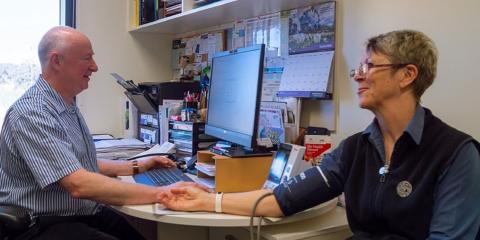An interview with Melbourne GP and Australian Digital Health Agency advisor Dr Nathan Pinskier.
For many decades, healthcare providers have relied heavily on the use of antiquated technology like the fax machine and letters delivered by post, to share important patient information such as test results and referrals.
But behind the scenes, the Australian Digital Health Agency has been working to change this, in partnership with the software industry and healthcare providers.

Dr Chris Harrison with patient
A number of secure messaging systems exist in the Australian healthcare landscape, designed to streamline information sharing between clinicians, allowing them to spend more time caring for patients.
However, as Melbourne GP and advisor to the Agency Dr Nathan Pinskier explained, to date, the ability of these systems to interconnect has been limited.
“There’s a variety of secure messaging systems that have been in place in the Australian marketplace for 15 to 20 years … but the one thing haven’t all been able to do is connect with each other — we describe this as interoperability,” Dr Pinskier said.
“The telecommunications providers worked out years ago that where you’ve got multiple providers, you need an ability to interconnect between each other.
“The same things happened in the banking sector – you can now generally go to any bank and withdraw your money from their ATM, whether you’re a customer of that bank or not.”
Delivering on the National Digital Health Strategy, the Australian Digital Health Agency has been working with the software industry and healthcare providers to solve similar interoperability issues in healthcare, by developing standards to improve the secure exchange of healthcare information.
Dr Pinskier said the quick and efficient transfer of information between clinicians has the potential to significantly improve healthcare outcomes for patients — and even save lives.

Melbourne GP and Australian Digital Health Agency advisor Dr Nathan Pinskier
As an example, if a doctor refers a patient to a hospital Emergency Department (ED) for treatment, quite often they’ll get very little or no information back, Dr Pinskier said.
“The patient may be admitted and discharged — and a day post discharge, they’ll come back to you and say ‘G’day Dr Nathan … didn’t you know I was in hospital for the last three weeks?’” he said.
“The patient assumes there’s a communications trail between the hospital and the GP, but the reality is that GP is often out of the loop until the patient returns for ongoing care or the discharge summary arrives.”
Secure messaging creates the opportunity for the hospital to send a ED notification back to the doctor, saying the patient has been seen, treated and admitted, Dr Pinskier said.
“More importantly, when they leave hospital and a discharge summary is created, it will be sent electronically to my practice — irrespective of which secure messaging vendor the hospital or my practice subscribes to,” he said.
When clinicians have timely access to as much relevant patient information as possible, they can make better treatment decisions.
“There’s been a number of Coroners’ cases that have clearly demonstrated that if clinicians had access to timely information, this would have made a big difference in terms of the outcome,” Dr Pinskier said.
“It (secure messaging) has the potential to save lives — there’s a massive safety case.”
Furthermore, clinical documentation created electronically for a primary purpose such as referrals, specialist letters and discharge summaries can also be uploaded to My Health Record. This creates a another benefit for consumers and other providers who may later be involved in the care of the patient.
The software industry, the clinical community and the Agency recently agreed on new standards for secure messaging that will ensure different systems can talk to each other — and under an agreement, the Agency will provide $30,000 to software vendors to integrate these standards into their existing clinical information and secure messaging systems.
The initiative has been put in place to accelerate the adoption of these new standards by software developers following two successful proof-of-concept projects in 2018.
“I’m extremely encouraged that the community has got together over the last few years and re-energised and re-focussed on this challenge,” Dr Pinskier said.
“What it clearly requires is a coordinated approach — from a policy perspective, from a technical perspective and from a change and adoption perspective.
“We’ve got the technical work happening … and a lot of work happening in the change and adoption space.
“I’d like to think over the next couple of years we’ll make significant strides forward.”